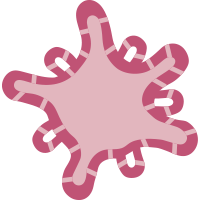
Organoid News
Organoid News is an online resource dedicated to the latest research about and featuring organoids.
A Mucus Production Program Promotes Classical Pancreatic Ductal Adenocarcinoma
Investigators explored intratumour heterogeneity and plasticity of cancer cell states in pancreatic dutal adenocarcinoma (PDA) in order to reveal cell state-specific regulators. They analyzed...
Oncostatin M Induces a Pro-Inflammatory Phenotype in Intestinal Subepithelial Myofibroblasts
[Inflammatory Bowel Diseases] The mRNA and protein expression of oncostatin-M and its receptors, gp130, and several fibrotic and chemotactic factors were studied in mucosal biopsies and isolated human intestinal subepithelial myofibroblasts of patients with inflammatory bowel disease and healthy controls and in a model of human intestinal organoids.
Multiplexed Bulk and Single-Cell RNA-Seq Hybrid Enables Cost-Efficient Disease Modeling With Chimeric Organoids
[Nature Communications] Scientists demonstrated the usefulness and necessity of a pooled design to reveal donor iPSC line heterogeneity during macrophage cell differentiation and to model rare WT1 mutation-driven kidney disease with chimeric organoids.
Modeling Blood-Brain Barrier Formation and Cerebral Cavernous Malformations in Human PSC-Derived Organoids
[Cell Stem Cell] Researchers constructed human blood-brain barrier (hBBB) assembloids from brain and blood vessel organoids derived from human pluripotent stem cells. They validated the acquisition of BBB-specific molecular, cellular, transcriptomic, and functional characteristics and uncovered extensive neuro-vascular crosstalk with a spatial pattern within hBBB assembloids.
Pannexin1 Channel-Mediated Inflammation in Acute Ischemic Stroke
[Aging and Disease] The authors summarized relevant studies on inflammation mediated by the pannexin1 channel in acute ischemic stroke and discussed the possibility of using brain organoid-on-a-chip technology to screen miRNAs that exclusively targeted the pannexin1 channel to provide new therapeutic measures for targeted regulation of pannexin1 channel to reduce inflammation in acute ischemic stroke.
FinalSpark Launches the First Remote Research Platform Using Human Neurons for Biocomputing
[FinalSpark (Businesswire)] FinalSpark launched the first-ever online platform enabling global researchers to conduct experiments remotely on biological neurons in vitro. The platform provided around-the-clock access to 16 human brain organoids aimed at developing the world’s first living processor.
Low-Intensity Ultrasound Ameliorates Brain Organoid Integration and Rescues Microcephaly Deficits
[Brain] Investigators reported that low-intensity ultrasound significantly increased neural progenitor cell proliferation and neuronal maturation in cortical organoids.
Screening Splice-Switching Antisense Oligonucleotides in Pancreas-Cancer Organoids
[Nucleic Acid Therapeutics] Scientists reported an efficient antisense-oligonucleotide lipofection method to systematically evaluate and screen individual splicing events as therapeutic targets in pancreatic ductal adenocarcinoma organoids.
Mapping of Mitogen and Metabolic Sensitivity in Organoids Defines Requirements for Human Hepatocyte Growth
[Nature Communications] Researchers characterized hepatocyte organoid outgrowth using temporal transcriptomic and phenotypic approaches. fetal hepatocytes initiated reciprocal transcriptional programs involving increased proliferation and repressed lipid metabolism upon initiation of organoid growth.
Brain Organoids Engineered to Give Rise to Glia and Neural Networks after 90 Days in Culture Exhibit Human-Specific Proteoforms
[Frontiers In Cellular Neuroscience] Scientists demonstrated that cell fate and composition of unguided brain organoids was dictated by culture conditions during embryoid body formation, and that culture conditions at this stage could be optimized to result in the presence of glia-associated proteins and neural network activity as early as three-months in vitro.
Efficient Hepatocyte Differentiation of Primary Human Hepatocyte-Derived Organoids Using Three Dimensional Nanofibers (HYDROX) and Their Possible Application in Hepatotoxicity Research
[Scientific Reports] Researchers attempted to culture human liver organoids established from cryopreserved primary human hepatocytes (PHH-derived organoids), using HYDROX, a chemically defined 3D nanofiber. While the proliferative capacity of PHH-derived organoids was lost by HYDROX-culture, the gene expression levels of drug-metabolizing enzymes were significantly improved.
Establishment of Human Hematopoietic Organoids for Evaluation of Hematopoietic Injury and Regeneration Effect
[Stem Cell Research & Therapy] To manufacture hematopoietic organoids, researchers obtained CD34+ hematopoietic stem and progenitor cells from human embryonic stem cells using stepwise induction and immunomagnetic bead-sorting.
Organoids are three-dimensional cell cultures that more accurately model cell behavior, organ function, and pathology than traditional two-dimensional cell culture. Organoid News was launched in 2020 to help scientists stay up-to-date with this revolutionary new research system. Use Organoid News to stay current with the latest applications and discoveries using organoids, as well as new reviews, jobs, news, and upcoming events.

 Cancer Stem Cell News
Cancer Stem Cell News Cell Therapy News
Cell Therapy News Dermal Cell News
Dermal Cell News Endothelial Cell News
Endothelial Cell News ESC & iPSC News
ESC & iPSC News Extracellular Matrix News
Extracellular Matrix News Hematopoiesis News
Hematopoiesis News Hepatic Cell News
Hepatic Cell News Human Immunology News
Human Immunology News Immune Regulation News
Immune Regulation News
 Intestinal Cell News
Intestinal Cell News Mammary Cell News
Mammary Cell News Mesenchymal Cell News
Mesenchymal Cell News Muscle Cell News
Muscle Cell News Neural Cell News
Neural Cell News Organoid News
Organoid News Pancreatic Cell News
Pancreatic Cell News Prostate Cell News
Prostate Cell News Pulmonary Cell News
Pulmonary Cell News
